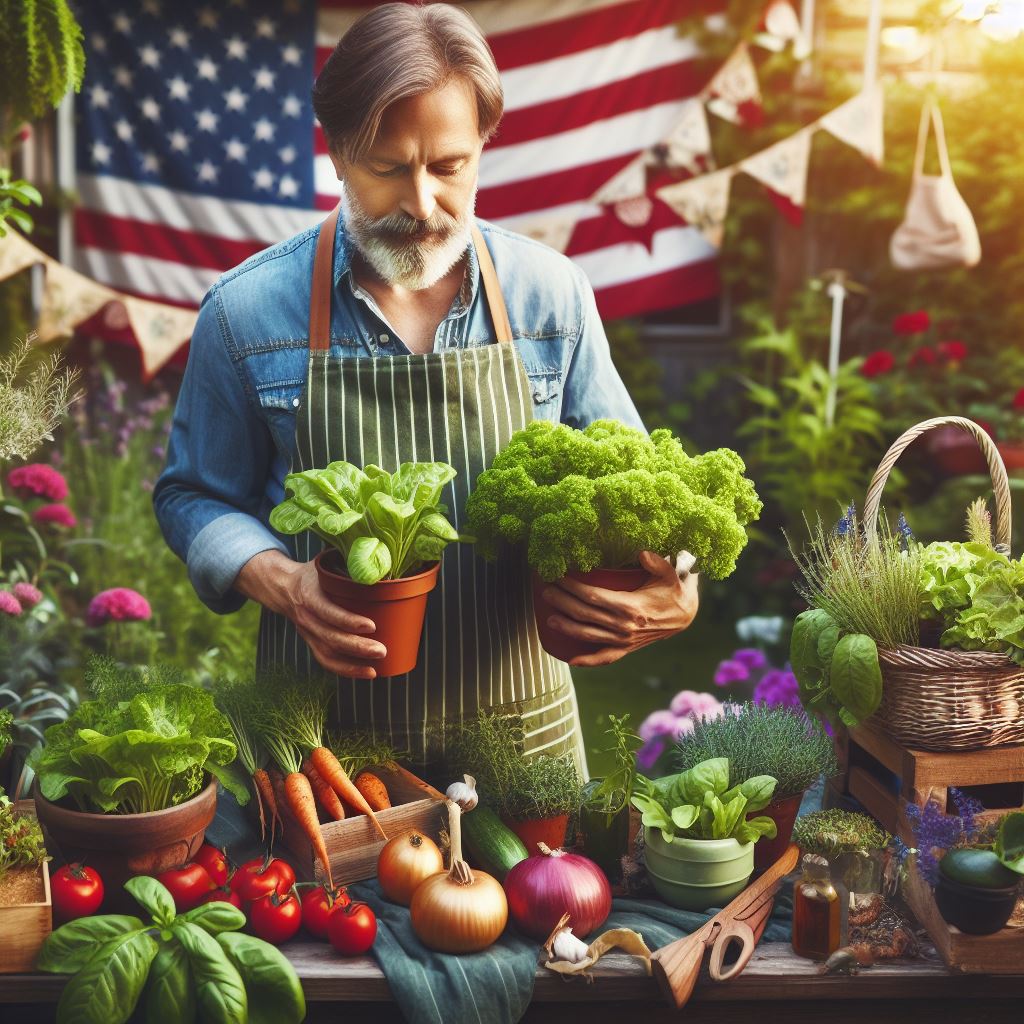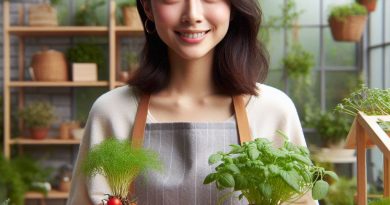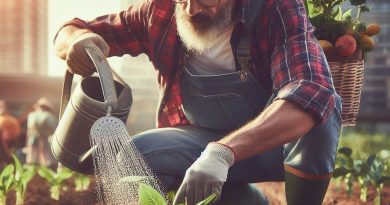Container Gardening: Organic Options
Last Updated on March 2, 2024
Introduction
Container gardening is a form of cultivating plants in containers such as pots or buckets.
It has gained popularity due to its numerous benefits.
Container gardening allows individuals with limited space, such as apartment dwellers, to enjoy gardening.
It provides an opportunity for people to grow plants in urban environments where traditional gardening may not be feasible.
Not only does container gardening save space, but it also offers flexibility.
Containers can be moved around, allowing plants to receive optimal sunlight or shade throughout the day.
Additionally, container gardening provides better control over soil quality and watering.
Gardeners can choose organic soil, ensuring plants receive the necessary nutrients without the use of harmful chemicals.
Container gardening encourages creativity as individuals can experiment with different plant combinations and arrangements.
It allows for personalized aesthetics, enhancing the overall look of balconies, patios, and other outdoor areas.
Furthermore, container gardening has therapeutic benefits.
Studies have shown that being around plants and nature can reduce stress and promote relaxation.
Container gardening also promotes sustainability by reducing food transportation carbon emissions.
Growing fruits, vegetables, and herbs at home decreases the reliance on store-bought produce.
Basically, container gardening is a practical and environmentally friendly way to enjoy gardening.
It offers flexibility, creativity, and therapeutic benefits while reducing reliance on external food sources.
Selection of Containers
Different types of containers
Selecting the right containers for your container gardening is crucial to ensure the success of your plants.
Let’s explore the various options:
- Clay pots: Clay pots are a popular choice for container gardening due to their classic and rustic charm. They provide excellent breathability for the roots and offer stability.
- Plastic pots: Plastic pots are lightweight and easy to move around. They are available in various colors and sizes, making them suitable for any type of garden or space.
- Wooden containers: Wooden containers add an organic and natural touch to your garden. They are durable and can withstand different weather conditions. However, they may require more maintenance compared to other materials.
Considerations for Choosing Containers
- Size and depth: The size and depth of the containers are vital factors to consider. Make sure the pots are large enough to accommodate the root system of your plants and provide ample space for growth.
- Drainage holes: Proper drainage is essential to prevent waterlogging and root rot. Ensure that your containers have enough drainage holes to allow excess water to escape.
- Material durability: Consider the durability of the container materials. Choose pots that can withstand outdoor elements like sunlight, rain, and frost. This will ensure the longevity of your containers.
- Aesthetics: Don’t forget about aesthetics! If you want to enhance the visual appeal of your garden, select containers that complement your overall design theme and the plants you’ll be growing.
By carefully selecting the right containers for your container gardening, you can create a beautiful and thriving garden space.
Assess your needs and preferences to make informed decisions when choosing containers.
Remember to consider the size, depth, drainage, durability, and aesthetics. Happy gardening!
Read: Pollinator-Friendly Gardening: Bees & More
Organic Soil Mix
Importance of Using Organic Soil for Container Gardening
Organic soil provides essential nutrients and promotes a healthy environment for plants to thrive.
Components of a Good Organic Soil Mix
- Compost Compost is rich in organic matter, improves soil structure, and enhances moisture retention.
- Peat Moss: Peat moss retains water well and ensures proper aeration in the soil.
- Vermiculite or Perlite Vermiculite or perlite helps with drainage and prevents soil compaction.
- Organic Fertilizers: Organic fertilizers nourish plants with natural nutrients while improving soil fertility.
Selecting Organic Seeds and Seedlings
Benefits of using organic seeds and seedlings
- Improved plant health and disease resistance due to natural genetic diversity.
- Avoidance of harmful chemicals and pesticides, promoting a healthier environment.
- Support for sustainable farming practices that protect soil quality and biodiversity.
- Enhanced nutritional value of resulting produce, rich in vitamins, minerals, and antioxidants.
- Promotion of non-GMO crops, preserving natural and organic plant varieties.
Sources for organic seeds and seedlings
- Local organic nurseries: Visit nearby nurseries specializing in organic gardening to find a wide range of organic seeds and seedlings. Engage with knowledgeable staff who can offer advice on selection and cultivation.
- Online retailers: Utilize online platforms that specialize in organic seeds and seedlings. These retailers often provide detailed descriptions, customer reviews, and convenient home delivery options.
When selecting organic seeds and seedlings, it’s essential to consider the following aspects:
- Seed Quality: Choose seeds from reputable sources that adhere to organic standards and ensure high germination rates.
- Certification: Look for seeds and seedlings bearing the USDA Organic seal or any other recognized organic certification to guarantee their authenticity.
- Varied Selection: Opt for a diverse range of plant varieties to promote biodiversity and lessen the risk of pest or disease outbreaks.
- Adaptability to Local Climate: Prefer seeds and seedlings cultivated in your region or ones known to thrive in similar growing conditions.
- Non-GMO: Choose non-genetically modified organisms (GMO) to support sustainable and natural farming practices.
- Disease Resistance: Consider selecting seeds and seedlings bred for disease resistance to reduce the need for pesticides.
By sourcing organic seeds and seedlings, you not only contribute to a healthier environment but also ensure the integrity of your container garden.
Remember to carefully follow the instructions provided by the supplier for optimal cultivation results. Happy gardening!
Read: Balcony Farming: Urban Organic Strategies
Organic Pest and Disease Control
Importance of organic pest and disease control in container gardening
In container gardening, organic pest and disease control plays a vital role in ensuring plant health.
Container gardens are more susceptible to pest infestations and diseases due to their confined environment.
However, using chemical pesticides can harm beneficial insects and contaminate the produce.
Therefore, employing organic methods is beneficial not only for the plants but also for the overall health of the ecosystem.
Natural methods for pest and disease control
Handpicking pests
Handpicking pests is a simple and effective approach to control infestations.
Regularly inspect your plants, especially the undersides of leaves, and remove any visible pests by hand.
This method helps prevent the pests from reproducing and causing further damage.
Companion planting
Companion planting is another natural method to control pests and diseases.
By strategically interplanting certain crops, you can repel pests or attract beneficial insects that feed on pests.
For example, planting marigolds alongside tomatoes can deter aphids and whiteflies.
Organic pest control products
Using organic pest control products is another option.
There are various organic sprays and oils available that can effectively eliminate pests without harming the environment.
Neem oil, for instance, is a commonly used organic pesticide that disrupts pests’ growth and repels them.
Proper plant spacing and regular inspections
Proper plant spacing and regular inspections are crucial preventive measures.
By providing sufficient space between plants, you promote air circulation, reducing the risk of disease transmission.
It also makes it easier for you to inspect the plants regularly for any signs of pests or diseases.
Early detection allows for prompt action and minimizes potential damage.
In general, organic pest and disease control is of utmost importance in container gardening.
With natural methods such as handpicking pests, companion planting, using organic pest control products, and maintaining proper plant spacing, you can effectively manage pests and diseases while keeping your plants healthy and free from harmful chemicals.
Embracing organic options not only safeguards your container garden but also contributes to a more sustainable and eco-friendly approach to gardening.
Read: Eco-Friendly Gardening: Sustainable Practices
Organic Fertilization
Importance of organic fertilizers in container gardening
Organic fertilizers enhance soil health, promote nutrient absorption, and improve plant vitality in container gardening.
Different types of organic fertilizers suitable for containers
- Compost tea: Rich in nutrients, it boosts soil fertility and aids in disease prevention.
- Fish emulsion: High in nitrogen, it stimulates strong root growth and overall plant development.
- Bone meal: Packed with phosphorus, it promotes flowering, fruiting, and root establishment.
Guidelines for applying organic fertilizers in containers
To ensure optimal results:
- Mix organic fertilizers into the potting soil before planting to distribute nutrients evenly.
- Follow the recommended dosage and application frequency specified on the fertilizer package.
- Water plants immediately after fertilizing to help nutrients penetrate the soil.
- Apply fertilizers around the drip line of the plants to avoid burning their roots.
- Monitor plant response to fertilization and adjust the frequency and dosage accordingly.
- Avoid over-fertilization, as it can lead to nutrient imbalances and damage to plants.
Container gardening offers an excellent opportunity to utilize organic fertilizers that nourish plants naturally.
Organic fertilizers feed the soil, fostering beneficial microbial activity and creating a sustainable growing environment.
These fertilizers are free from harmful chemicals and provide a safe means of enriching container gardens.
Importance of organic fertilizers in container gardening
Organic fertilizers play a vital role in container gardening for several reasons.
Firstly, they promote soil health by improving its structure and texture.
Organic matter in these fertilizers enhances water retention and aeration, creating a balanced environment for root growth.
As a result, plants develop strong, healthy root systems, leading to better overall growth and productivity.
Additionally, organic fertilizers are rich in essential nutrients that are slowly released into the soil.
This gradual release ensures a consistent supply of nutrients, reducing the risk of nutrient deficiencies or excesses in container plants.
Moreover, organic fertilizers are less likely to leach out of the soil, minimizing the risk of environmental pollution.
Different types of organic fertilizers suitable for containers
There are various types of organic fertilizers suitable for container gardening.
Compost tea, for instance, is made by steeping compost in water.
This nutrient-rich liquid can be applied directly to the soil or used as a foliar spray, providing readily available nutrients to plants.
Fish emulsion, another popular organic fertilizer, contains high levels of nitrogen, promoting lush foliage development and vibrant colors.
Bone meal, on the other hand, is rich in phosphorus, which aids in root establishment and encourages blooming in flowering plants.
Guidelines for applying organic fertilizers in containers
When applying organic fertilizers in containers, it is essential to follow specific guidelines.
Mix the fertilizers thoroughly into the potting soil before planting to distribute the nutrients evenly.
This ensures that every plant receives an adequate supply of essential elements.
Additionally, it is crucial to adhere to the recommended dosage and application frequency specified on the fertilizer package.
Over-fertilizing can lead to nutrient imbalances and potentially harm plants.
Watering immediately after fertilizing helps the nutrients penetrate the soil and reach the plant’s root zone effectively.
Applying fertilizers around the drip line of the plants, rather than directly on the stems, is advisable to prevent root burn.
Monitoring plant response to fertilization is also essential.
If plants exhibit signs of nutrient deficiency or excess, adjustments in dosage or frequency may be necessary.
In essence, organic fertilizers offer numerous benefits in container gardening.
They improve soil health, provide a gradual release of essential nutrients, and promote sustainable plant growth.
By following guidelines for their application, gardeners can maximize the benefits of organic fertilizers and enjoy thriving container gardens.
Read: Urban Oasis: 5 Steps to Perfect Container Gardens

Maintaining Container Garden Nutrition
Achieving optimal nutrition for your container garden is vital to ensure the health and productivity of your plants.
By regularly monitoring soil nutrient levels and understanding the specific requirements of your plants, you can provide them with the necessary nutrients for their growth and development.
Regularly monitoring soil nutrient levels
- Conduct regular soil tests to assess the nutrient composition and pH level of your container garden soil. This will help you determine any deficiencies or imbalances.
- Adjust the nutrient levels accordingly by adding organic fertilizers or amendments such as compost, worm castings, or seaweed extract.
- Keep track of the nutrient application rates and schedule regular fertilization to ensure a consistent supply of nutrients for your plants.
Understanding plant requirements for optimal nutrition
Nitrogen
- Nitrogen is essential for plant growth, leaf development, and the production of proteins and chlorophyll.
- Plants with high nitrogen needs include leafy greens, broccoli, and corn.
- Apply organic nitrogen-rich fertilizers like blood meal, fish emulsion, or alfalfa meal to meet these requirements.
Phosphorus
- Phosphorus promotes root development, flowering, and fruit formation in plants.
- Plants that benefit from adequate phosphorus levels include tomatoes, peppers, and beans.
- Add organic phosphorus sources such as bone meal, rock phosphate, or guano to provide sufficient phosphorus to your plants.
Potassium
- Potassium contributes to overall plant health, disease resistance, and the regulation of water uptake.
- Fruiting plants like strawberries, cucumbers, and melons have higher potassium requirements.
- Use organic potassium-rich fertilizers like wood ash, kelp meal, or granite dust to ensure an ample supply of potassium.
By understanding the nutrient needs of your plants and providing them with the appropriate organic fertilizers, you can maintain their optimal nutrition.
Avoid over-fertilization
However, it is crucial to avoid over-fertilization, as excessive nutrient levels can lead to imbalances and harm your plants.
Regularly observe your plants for any signs of nutrient deficiencies, such as yellowing leaves, stunted growth, or poor fruit set.
Adjust the nutrient levels accordingly and consider foliar feeding for a quick nutrient boost if needed.
Proper watering practices
In addition to fertilization, proper watering practices also play a crucial role in maintaining container garden nutrition.
Overwatering can wash away essential nutrients, while underwatering can lead to nutrient accumulation and deficiency.
In a nutshell, a well-maintained container garden requires regular monitoring of soil nutrient levels and the understanding of specific plant nutritional requirements.
By providing the right balance and organic sources of nitrogen, phosphorus, and potassium, you can ensure the optimal nutrition of your plants and enjoy a bountiful harvest.
You Might Also Like: Guide to Garden Tool Maintenance & Care
Harvesting and Storing Organic Container Grown Produce
Indications for harvesting different plants
Harvesting your container-grown produce at the right time ensures optimal flavor and nutrition.
Here are some indications for harvesting popular plants:
- Tomatoes: Wait until they are fully colored and firm but slightly yielding to touch.
- Lettuce: Harvest leaves when they reach a desirable size, or harvest the whole plant.
- Peppers: Harvest when they are fully grown, but still green or as they begin to change color.
- Herbs: Snip individual leaves or stems as needed, ensuring a continuous supply.
Proper storing techniques for organic produce
Once harvested, it’s important to store your organic produce properly to preserve its freshness and flavor.
Here are three effective storage techniques:
Refrigeration
Refrigerating organic produce helps slow down spoilage and extends its shelf life.
Follow these tips for refrigeration:
- Separate fruits and vegetables: Fruits release ethylene gas, which can spoil vegetables quickly.
- Store in bags: Use perforated plastic bags or reusable produce bags to maintain moisture levels.
- Temperature and humidity: Set your refrigerator to the appropriate temperature and adjust humidity levels if possible.
Canning
Canning is a great option for preserving organic produce, especially if you have a surplus.
Follow these steps for safe canning:
- Prepare the produce: Wash and blanch vegetables, remove pits or seeds from fruits.
- Choose appropriate jars: Use glass canning jars with new lids for proper preservation.
- Follow canning instructions: Follow a trusted canning recipe and process for the specific produce.
Freezing
Freezing organic produce allows you to enjoy it for an extended period.
Here’s how to freeze your organic harvest:
- Wash and prep: Clean and chop vegetables or blanch delicate fruits before freezing.
- Use freezer-safe containers: Store in freezer bags or containers designed for freezing.
- Label and date: Make sure to label and date your frozen produce to keep track of freshness.
By using these storing techniques, you can enjoy the flavors of your organic container-grown produce throughout the year.
Conclusion
Creating an urban oasis no longer requires a spacious backyard or large garden beds.
Container gardens enable city dwellers and those with modest spaces to cultivate ornamental joy and edible delights using organic methods.
Container gardening offers multiple practical advantages while nurturing the earth and protecting pollinators.
You control the soil quality by filling pots with rich organic mixes.
Maneuverable containers let you optimize sunlight exposure, capture rainfall, or shelter plants during storms.
Organic containers and fertilizers avoid toxic chemicals that pollute groundwater.
Careful plant choices, proper watering, smart siting, and creative combinations keep container plants thriving with nature’s bounty.
Whether you have a tiny apartment balcony, shared community garden, or small suburban patio, the benefits and beauty of container gardening using organic techniques await your green thumb.
Join the blossoming movement of eco-gardeners growing gorgeous potted arrangements with permaculture methods.
Commit to the planet’s future while enjoying nature’s gifts today through organic container gardening in urban spaces.


